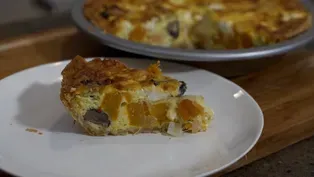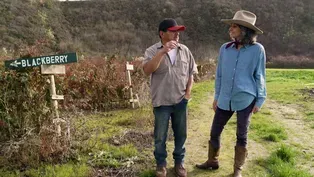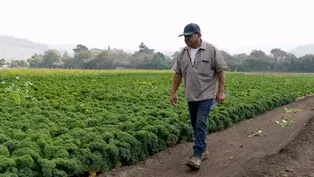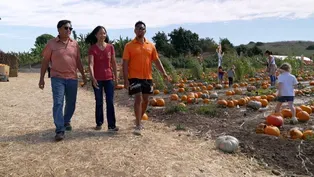
Connecting and Feeding the Community
Clip: 8/9/2024 | 3m 20sVideo has Closed Captions
Discover how an urban school in the middle of a food desert built its own farm.
An urban school in the middle of a ‘food desert’ in Southern California planted its own farm that’s feeding the neighborhood.
Problems with Closed Captions? Closed Captioning Feedback
Problems with Closed Captions? Closed Captioning Feedback
America's Heartland is presented by your local public television station.
Funding for America’s Heartland is provided by US Soy, Sustainable Agriculture Research and Education, Rural Development Partners, and a Specialty Crop Grant from the California Department of Food and Agriculture.

Connecting and Feeding the Community
Clip: 8/9/2024 | 3m 20sVideo has Closed Captions
An urban school in the middle of a ‘food desert’ in Southern California planted its own farm that’s feeding the neighborhood.
Problems with Closed Captions? Closed Captioning Feedback
How to Watch America's Heartland
America's Heartland is available to stream on pbs.org and the free PBS App, available on iPhone, Apple TV, Android TV, Android smartphones, Amazon Fire TV, Amazon Fire Tablet, Roku, Samsung Smart TV, and Vizio.
Providing Support for PBS.org
Learn Moreabout PBS online sponsorship[♪♪♪♪♪] Narr: When the COVID pandemic shut down California public schools in 2020, many campuses within the Anaheim Union High School District became Food distribution centers.
Sabina Giokoumis is a teacher at Magnolia High School, took notice.
Sabina: We saw how many people needed produce, so we knew that there was a need um, that -- and a problem that we could solve for our community by building the farm.
Narr: The farm is the Magnolia Agriscience Community Center, or MAC for short.
Building it was Anaheim's response to California's ambitious $3 billion initiative to dramatically expand its number of community schools.
Public schools that not only educate students but also provide support and services to the neighborhood as a whole.
Jaron: What we're standing on used to be an empty dirt lot.
Students have identified food deserts as a very real issue that is facing our community where there's fast food restaurants, all around us, but there's not a lot of grocery stores or places for families to go to get organic, healthy foods.
So and this is contributing to obesity and health issues that we're seeing in our community.
Mimi: The only foods that are really there for the community are junk food and things that do not benefit or give us any nutritional value.
And us as students, found community gardens as a very good and efficient solution.
I'm seeing the vegetables and fruits being grown in our MAC, the Magnolia Agroscience Community Center being taken into our cafeteria.
I've also seen it helping families and parents and students by providing them with locally sourced, healthy, nutritious food.
Monty: So every month we have this thing called the community dinner, so anyone in the community can come to our school they could... they could buy our produce, they could taste our produce.
Jaron: We have boxes that we sell to local communities, to local families that are... that are taking these boxes and they are bringing... bring these foods into their homes.
So this is like quasi grocery store.
Intern: For every pound of textiles produced in Indonesia - Narr: The farm feeds the community, but it also helps educate the students.
Their instructors are interns from the University of California, Irvine, Sabina: They teach lessons around pollination, around sustainable agriculture, around pesticides and runoff.
Growing Food in a changing climate.
Using UCI science students as our teachers so gives them a little teaching experience.
It gives us smaller class group sizes to learn about urban farming and sustainable agriculture Jaron: And then the learning that is happening here with our students, they're able to go back and speak to their families, speak to their four friends.
And we're seeing a ripple effect in terms of making healthy... healthier choices.
Narr: Sabina Giokoumis believes California's initiative to increase the number of community schools is vital.
Sabina: In a time right now in America, where so many of our schools are building up walls around our schools for safety, that does feel a little bit like we as the community are being pushed away or what happens inside of schools is secret.
And so it is important that we... that we reach out to our communities and let them know we're here.
We have resources, come in, tell us what your community issues are so that we can become an asset and problem solve alongside with you.
Autumn Vegetable Quiche – Farm to Fork with Sharon Profis
Video has Closed Captions
Clip: 8/9/2024 | 5m 41s | Find out how to cook an autumn vegetable quiche with mushrooms and leeks. (5m 41s)
Growing Perennials – Harvesting Health
Video has Closed Captions
Clip: 8/9/2024 | 4m 6s | Explore the nutritional benefits of berries with our health expert. (4m 6s)
Video has Closed Captions
Clip: 8/9/2024 | 4m 18s | A former farm laborer starts his own farm selling berries and rosemary. (4m 18s)
Video has Closed Captions
Clip: 8/9/2024 | 5m 50s | Visit a pumpkin patch that attracts tens of thousands of people a year. (5m 50s)
Providing Support for PBS.org
Learn Moreabout PBS online sponsorshipSupport for PBS provided by:
America's Heartland is presented by your local public television station.
Funding for America’s Heartland is provided by US Soy, Sustainable Agriculture Research and Education, Rural Development Partners, and a Specialty Crop Grant from the California Department of Food and Agriculture.















